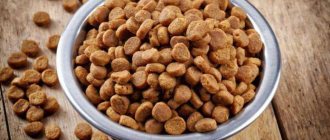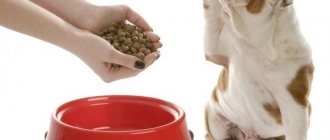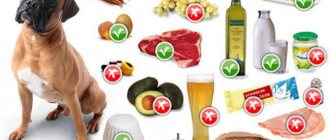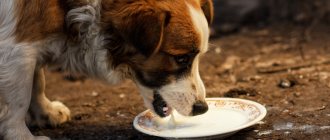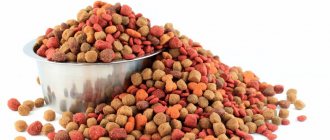Using dry dog food is very convenient - it is not surprising that many dog owners choose this feeding method. But a dog’s diet based on dry nutritional granules must be prepared according to the rules - in particular, a certain volume must be observed so that the animal does not starve or suffer from obesity. How many grams of dry food to give a dog per day is not an easy question, since not only the size of the dog is taken into account, but also a number of other factors.
What determines the size of the daily portion?
Despite the fact that every second dog eats dry food, not all owners know how to correctly calculate the amount of dry food for their pet. Proper calculation of a single serving is important for the health of the animal, since overfeeding can lead to obesity, and excess weight, in turn, will lead to other serious problems.
The food packaging usually lists the recommended daily allowance for a particular product. Quite often they are significantly overestimated, since manufacturers are simply not able to take into account all the features of your pet. Therefore, inexperienced dog breeders often consult dog trainers and veterinarians.
How much dry food a dog needs per day depends on the following factors:
- pet breed;
- weight and dimensional characteristics;
- lifestyle (where the pet lives, how many times it goes for walks, physical activity);
- age of the animal;
- physiological state (pregnancy or lactation, recovery from illness or surgery, and others);
- health status (presence of chronic diseases).
Thus, it is necessary to collect all individual information about the animal before calculating its daily nutritional intake. It is better if dry food is selected by the owner together with a veterinarian. Remember - under no circumstances should you overfeed the animal. It is completely normal for your dog to feel hungry during the day, which means he will have a good dinner. Excessive satiety only harms four-legged animals.
In general, the average daily intake of dry food for adult animals, depending on weight and physical activity, can range from 200 to 900 g per day. In this case, the dog needs to be fed 2 times a day. The nutrition of puppies follows a slightly different pattern - they are fed more often, dividing the daily portion into 3-6 meals.
Feed after fodder - discord
Nutrition is a very individual thing, and one animal will feel good on food that is completely unsuitable for another. Individual reactions, of course, must be taken into account, but still, unlike absolutely omnivorous people, the nutritional needs of dogs are limited and can be satisfied primarily by food with a high meat content. If there is not enough of this component in the diet, then certain health problems are inevitable, so if you are going to feed your dog only dry food, choose the product correctly.
The basis of the feed should be animal protein sources, and the carbohydrate content should be kept to a minimum. To understand how much meat is in a food, you need to look at the first five ingredients in its composition list. These should be meat components, preferably added fresh (this way more nutrients are retained) and named absolutely clearly and clearly - without streamlined formulations, such as “meat and its processed products”, “sources of animal protein”, etc.
It is advisable to avoid foods containing grain products, as they are completely unsuitable for dogs, have low nutritional value for carnivores and at the same time are high in calories, which can lead to excess weight and the risk of diabetes.
With the right choice of dry food, the dog will feel great, and you will immediately notice this by the activity of the pet, its shiny coat and the impeccable functioning of the gastrointestinal tract. This food can be fed to a dog for the rest of its life without any harmful consequences.
How many times a day do you feed a dog?
The frequency directly depends on the age of the animal. Puppies are given shorter intervals between feedings and a larger number of meals.
Puppy
From the age of three weeks, puppies begin to be accustomed to solid food. The number of feedings reaches 5-6 times a day.
Once the puppy reaches two months of age, the number of feedings is reduced to 3-4, after six months of age - to 2. Animals one year old and older, depending on their physical condition, are fed twice a day.
Adult
An adult dog is fed twice a day – in the morning and in the evening. It is necessary to observe a strict interval between serving food - 12 hours - and not move it under any circumstances. The regime can be broken if you need to fast before tests or surgery.
For pregnant females, the frequency of feedings is increased only in extreme cases - usually an increase in portion size is enough.
Adult dogs are fed three to six times a day if they are on a diet to treat a serious illness. When the pet’s well-being improves, the pet is transferred to the usual two meals a day.
Insufficient water consumption
Negative experiences with using ready-made diets are often associated with improper drinking regime. Do not forget that dry food contains virtually no moisture, while in natural products and canned food its share reaches 60–80%. This means that the pet must receive additional water.
If you feed your puppy dry food, keep water freely available around the clock and change it at least 2-3 times a day. When leaving home, leave him not one, but two bowls of drink. Otherwise, if he accidentally turns the container over while playing, he won’t drink all day. It is wise to purchase an automatic drinking bowl that will provide the animal with clean, fresh water even in the absence of the owner.
How much food does a dog need per day: tables
You can independently calculate how much dry food your dog needs per day using a table that shows the required number of calories per day. In this case, you need to know the energy value of the selected food - it is indicated on the packaging.
Please note that premium and holistic food is more nutritious and you need a little less of it than a regular economy class product.
For puppies
To correctly calculate the amount of food for babies, you will need to know their weight and calorie content of food. Approximate data per 1 kg of weight can be seen in the table below.
| Puppy age (in months) | Daily kcal norm per 1 kg of weight in grams | Quantity of feed (in grams per 1 kg of body weight) |
| Up to 1 | 220-250 | 15-20 |
| 1-3 | 260-280 | 17-25 |
| 3-4 | 200-230 | 20-30 |
| 4-8 | 120-150 | 25-35 |
| 8-12 | 100-130 | Calculation for adult animals is used |
For small dogs, the portion will be smaller than for puppies of larger breeds.
Adults of small breeds
The daily allowance for adult small breeds (weighing up to 15 kg) is 300-400 g of food if we are talking about economy class, and 150-300 g if you give your pet premium or holistic.
| Dog weight, kg | Amount of feed during normal activity (grams per day) | Amount of feed at high activity (grams per day) |
| 2-5 | 30-80 | 50-100 |
| 5-9 | 100-160 | 160-200 |
For dogs whose weight starts from 10 kg, with good walking and play, 150-170 g are required, for their less active relatives - 120-150 g. Further, the rate of one serving increases by 100 g for every 10 kg. That is, if an animal weighs 20 kg, it needs 250-270 grams of food per day, 30 kg - 350-370 g, etc.
Adults of large breeds
Large and giant breeds include dogs weighing 35-65 kg or even more. Large animals need to be fed with a large amount of food, but overfeeding should not be allowed. The calculation is made according to the following table:
| Dog weight, kg | Amount of feed during normal activity (grams per day) | Amount of feed at high activity (grams per day ) |
| 30-39 | 400-440 | 410-500 |
| 40-49 | 450-520 | 500-600 |
| 50-60 | 520-650 | 600-700 |
Large breeds have a good appetite, but their metabolism is much slower than that of small breeds. Therefore, nutritious, but not too high-calorie food is produced for them.
You can't ignore your dog's individual needs. If you begin to notice that, while eating according to the norms on the packaging, the dog has begun to gain excessive weight, reduce the portions or remove one feeding. If he eats and asks for more, while losing weight, increase the portion or switch to a higher-calorie product.
Is it possible to feed a dog only dry food?
Contents hide
Dry food is a convenient and easy diet option. But is it good for pets?
At least half of domestic dogs these days eat dry food of various brands. Most of these pets live happy and healthy lives for many years. Sometimes owners add wet food to dry food, since some four-legged pets eat it with greater appetite. However, this does not mean that a completely dry diet will harm your dog. The main thing is to choose the right food from the many available in pet stores, and it is advisable to consult a veterinarian.
Among dog products, dry food was the first to appear (back in the 1890s!) and for several decades remained the only commercially available option. Then wet food began to be sold, and dog nutrition standards changed significantly. Pet products now contain higher quality ingredients and are richer in nutrients. Dry food consists of a certain percentage of protein and fats necessary for the health of dogs. What to choose?
Benefits of dry food. Dry food is perfect for young dogs with healthy teeth, as well as for puppies whose teeth are changing.
- A good dry dog food will contain between 18 and 32% protein and between 8 and 22% fat. When choosing a brand of food for your pet, carefully read the ingredients. The given numbers are optimal. If the food contains enough nutrients, you may not need to give your dog additional vitamins.
- Dry food contains carbohydrates that give your dog energy.
- The range of feeds is so extensive that you will definitely be able to choose a decent option.
- Dry food does not spoil longer than liquid or natural food. If you are away from home for a long time, this is the best way to provide your dog with food for a few hours.
- Dry food is cheaper than liquid food, but is generally not inferior in quality.
Benefits of liquid food. When liquid food appeared, some dog lovers began to believe that it was healthier than dry food. In reality this is not entirely true. Here's who liquid food is suitable for:
- Dogs with severe dental problems;
- Elderly pets;
- Puppies who have just begun to feed on their own after milk feeding.
- For pets that need a small amount of carbohydrates (for example, those prone to gaining excess weight). Wet dog foods are often higher in protein and fat, but lower in carbohydrates.
Do I need to switch from wet food to dry food? Before deciding to change food, consult your veterinarian. As a rule, the transition from wet food to dry food (and vice versa) occurs due to the health of the pet. If you get permission from your veterinarian, gradually add dry food to the portion of wet food. This will prevent your dog from getting stomach problems. During the habituation period, you should also eliminate any other food sources (such as treats and human food) to ensure that you are not allergic to the new food. If your veterinarian recommends against switching to dry food, take the advice of a professional. There are many diets and diets for dogs that will be a good alternative to commercial food.
Photo:
Calculation of dog food for 1 serving
Knowing the daily volume of food, it is not difficult to calculate the amount of granulated food served in one feeding.
How to determine the mass of a serving
How to calculate the amount of food for a dog: you need to divide the daily amount by the number of feedings; for adult animals this is two. The amount of food per 1 kg of body weight per day for an adult dog depends on the breed, weight and calorie content of the food (see above).
Active animals, service dogs or athletes need special consideration, as well as pregnant and lactating women. To the usual dosage of dry dog food, approximately 1/3 of the serving is added for working dogs and 1/4 for pregnant and lactating dogs. If the dog is elderly and inactive, the portion should be reduced by about 1/3.
How to measure the required weight
It’s definitely not possible to measure dry food without a scale. Therefore, if you want to know the perfectly accurate amount of feed, you will have to purchase a kitchen scale.
Manufacturers of some expensive foods include special measuring cups in the pack, with which you can pour the desired portion. However, it is worth remembering that such a container is designed only for this brand, because all dry products have granules of different densities, sizes and weights.
If you count only approximately, the food can be poured into a 100 ml cup - it will be about 240-250 grams. When buying food in bulk, you can ask the seller to divide the product into several parts equal to the daily feeding rate. And at home you can simply divide them in half: for breakfast and dinner.
How to give dry food to your dog according to the schedule
An important point when feeding dogs is compliance. It is recommended to give food to an adult dog twice a day, at the same time. The dosage of dry food, which you determined from the table, must be divided into two equal portions. Each of them must be poured into a bowl at the specified time. For example, at 7.00 and 19.00 or at 8.00 and 20.00. The meal schedule may be different, the main thing is that it does not conflict with your work schedule and is observed daily.
Between meals, do not leave dry food freely available (with the exception of the lactation period, as we wrote about above). If the dog did not eat all the food offered or completely ignored it, hide the bowl until the next feeding. Then continue feeding on the usual schedule and in the usual volume. This approach prevents overfeeding and promotes discipline.
Soaking the feed
If the manufacturer does not indicate restrictions on soaking the feed and such information is not on the packaging, the granules can be soaked. It is especially useful to do this for older dogs, sick individuals and puppies up to three months old.
To do this, you need to fill the granules by half or a third with unboiled drinking water, heated to about 40°C. Boiled milk is sometimes added to the puppy.
Soaked food cannot be stored for a long time - a maximum of three hours. It is dangerous to use it after longer storage, as it turns sour very quickly. Regardless of whether the dog eats dry food or soaked food, the norm is the same.
Drinking regime for “dry feeding”
If the animal is fed only dry foods, then the required daily amount of liquid is calculated using the formula: 50 ml of water per kg of body weight.
Of course, you don’t need to give your dog water at certain intervals. She should have a free approach to drinking water and satisfy her own needs. And needs may vary depending on numerous conditions: age, physical activity, time of year, etc.
The water should always be clean - it needs to be changed every few hours. If this is not possible, a special automatic drinking bowl for dogs will come to the rescue. You should not use boiled water: the best option would be filtered or bottled water without gas. Raw water is strictly prohibited.


